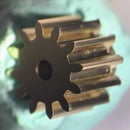Introduction: Turning a Weiss Distribution Tool on a Miniature Lathe
A Weiss distribution tool (also known as a puck rake) breaks up any clumps in the bed of coffee, which helps to prevent channeling. This means the grounds are more evenly extracted, which can improve the flavour of the espresso.
This makes a nice little wood-turning project for a small lathe. It's very easy to make, which makes it an ideal beginner's project.
Supplies
Tools:
- Stock preparation:
- Hand plane
- Saw
- Marking knife or pencil
- Try-square
- Wire cutters
- Shaping:
- Small lathe
- Drilling attachment or any kind of drill
- Files
- Saw
- Pocket knife / carving knife
- Sandpaper
Materials:
- Handle material (I used mahogany but you could use a different wood, metal, or resin blank)
- Cyanoacrylate glue (ideally low-viscosity but superglue works too)
- Wire
- Danish oil (or suitable paint or wax)
Step 1: Preparing the Prongs
I made my prongs from 0.5 mm titanium wire but stainless steel would work well too. 40 mm is a good length to aim for, ensuring the prongs will reach the bottom of the portafilter.
Step 2: Preparing the Handle Blank
You can skip this step if you have a nice cuboid or cylindrical blank already. I cut a blank from a piece of mahogany.
Make sure you keep your blank longer and wider than your final intended shape, so you've got room to hold the end and have some leeway in case it's not mounted concentrically in the chuck.
Step 3: Shaping the Blank
Here are the steps I took in shaping the handle:
- Mount the handle blank in the 4-jaw chuck. (You can use a 3-jaw if working from a cylindrical blank.)
- Rough the blank into a cylindrical shape.
- Tilt the top slide over to add a taper.
- Use round and half-round files to add more complex curves to the handle profile. This can also be done with a handrest and chisels if preferred.
- Sand the handle.
Step 4: Drilling the Holes
In the video, you'll see I'm using a drilling attachment in combination with a dividing setup on my miniature lathe. This is a great way to drill precisely angled holes but if you're not worried about precision, you can use whatever drilling tools you have easy access to. I drilled the holes around 5 mm deep, using a 0.5 mm drill bit - don't worry too much about getting an accurate depth as you can trim the prongs down later.
Step 5: Cutting Off & Cleaning Up
I sawed off the handle from the remaining blank. You can do this in the lathe as long as you put a cover down to protect the bed from any stray saw cuts. I used my pocketknife (which you might recognise from a previous instructable) and some sandpaper to tidy up the sawn-off end.
Step 6: Gluing in the Prongs
The prongs should fit snugly in the holes but a dab of glue keeps them more secure. I'd recommend using low-viscosity cyanoacrylate glue, such as the type used for inlays, but standard superglue is fine too.
Once the glue has set, trim down the prongs to an equal length.
Step 7: Finishing Touches
I like how mahogany looks with a coat of Danish oil so that's what I used to finish my handle. Use whichever wood finish works best for you.
The Weiss distribution tool is now complete and ready for use. Thanks for reading.

Runner Up in the
Anything Goes Contest













